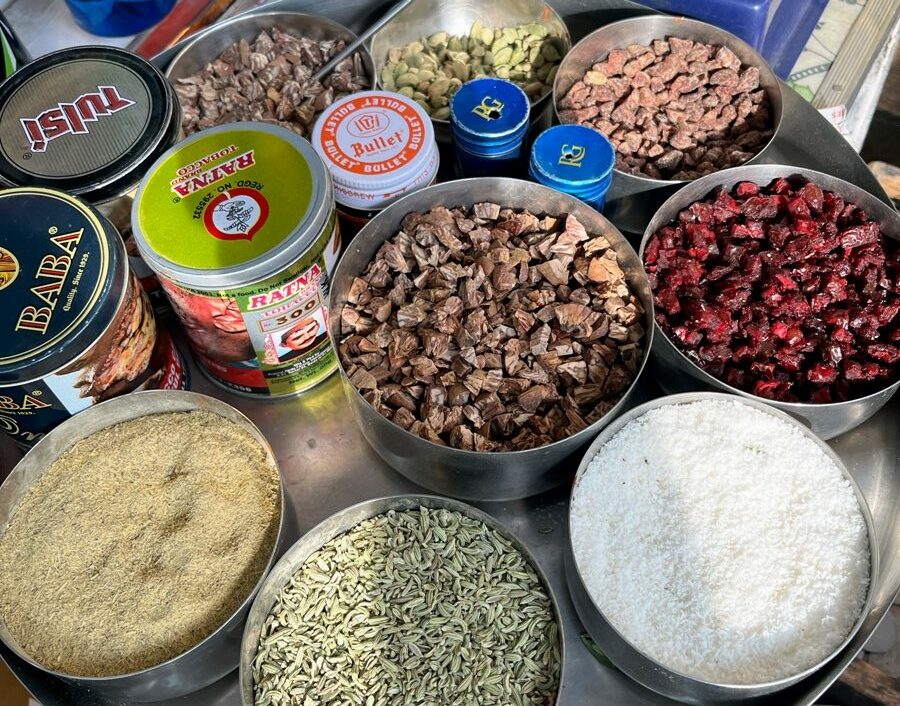by MJ Aslam
And, the young ladies loved to hear and hum pan khae Sainya hamaro, sanvali suratiya hont lal lal, a musical melody of Asha Bhonsley from Teesri Qasam of 1966.

Pan is the commonly known name of piper-betel-leaf, which is chewed in the Indian subcontinent and some other parts of the world. How the betel leaves chewing came to Kashmir is an interesting study.
In Rajatarangini, there are references to Tambuli and Nagarakhanda leaves, which were brought as presents to some Brahman Rajas, namely, Jayapida, Ananta, Kalasa, Harsa, in ancient times by “foreigners” which included mostly dancing girls.
Ranjit Sitaram has equated Tambuli and Nagarakhanda with piper-betel leaves, while, according to Dr M A Stein believes Nagarakhanda leaves are not betel-leaves. He translates Nagara as ginger but adds that Nagara was never used as an ingredient of betel leaf chewing. Ranjit Sitaram’s translation of Rajatarangini is based, in his own words, on Stein’s acclaimed translation. On Sitaram’s translation, some bloggers have tried to link the modern kind of betel-leaf-chewing to ancient times.
According to Stein, transporting fresh betel leaves from outside till the recent past was most difficult in absence of facilities and hence the practice of chewing fresh betel leaves (pan) was totally unknown to “Kashmiri masses” in history; albeit, some Brahman kings, their attendants and dancers had a habit of chewing “betel leaves”, which had made their teeth red.
On record, however, betel-nut/catechu was imported to Kashmir from Punjab in the late nineteenth century as a spice or medicine but not as an ingredient of any betel-chewing [pan masala] which was unknown to the native population.
For Lip Beauty
Notwithstanding the aforementioned, chewing betel was an ancient practice all over the Indian subcontinent during medieval and post-medieval times. Betel was used by both men and women to dye their lips red and make them look attractive. People in the olden days were as anxious to look young, bright and beautiful as in our times. It was used to redden the lips to serve as a lipstick by womenfolk in the past.
It was used as a masticator. Under common belief, that pan strengthens the stomach, sweetens the breath, and gives the tongue, lips and teeth a reddish tinge. It was customary among people of the Indian subcontinent, all classes and communities, to take pan after their meals but many people developed the practice of taking it throughout the day. The areca nut (supari) was/is cut into small pieces, put in betel leaf with lime water, called Katha (lime made by Oyster and areca) and chewed with rolled betel leaf. The rich would mix with it costly spices like camphor, cardamom, cinnamon, honey, musk flavours, and dried-rose-petals and tie both its leaves with a silk thread, and keep it in golden and silver betel boxes (pan dabi). Some people bruised a portion of falafel (areca nut/sopari) and put it directly in the mouth as a nasha like a cigarette or tobacco.
A betel leaf was moistened together with a grain of chalk/lime, rub one upon the other, roll them together, and then place in the mouth. It was used by such people as opium. Some people took as many as four leaves of betel at a time, and chew them. Sometimes they spit out red-colour saliva. Some used spittoon (pan dani) for spitting out red colour saliva.
Among common Hindus, it was offered to the bridegroom and attendants (Baratis) at the bride’s house with sweet drinks. Abul Fazl mentions 16 items of women’s fashion and charm in the Mughal Era among all communities which included pan eating also. The royals kept pans in golden and silver boxes, while the common masses kept them in brass and wooden boxes.
Kashmir Dandas
In Kashmir, we had an old tradition of using the bark of walnut-tree (dandas) by womenfolk to brighten the teeth for a beautiful look and keep the oral health good. It was believed that the use of dandas kept teeth and gums stronger, besides refreshing the breath. Betel leaves were not used by men and women in Kashmir.

The tradition of pan-chewing appeared in Kashmir only after 1953 when Sheikh Mohammad Abdullah was removed from office and incarcerated for a decade. It was inducted into Kashmirian society during the Bakhshi era (1953-1963).
Betel does not grow in Kashmir. In the late 1950s, several pan-shops appeared first in the city centre of Court Road, Palladium cinema, Ameera Kadal, Residency Road, Habba Kadal, and then at Exchange Road, Khanyar, Bohri Kadal, and other places till the 1970s.
The earliest of these pan-shops was one of a Pandit at Habba Kadal, Mir Pan House at Residency Road, Regal Chowk and Churasia Pan House at the corner of Court Road opposite Palladium Talkie. Pan has a variety of metha pan, alaichi pan and tobacco pan. The fennel seeds, coconut powder and clove became added ingredients to the pan masala.
Credible eyewitnesses have recorded that in Bakhshi and Sadiq regimes, new trends of life, style and fashion appeared among Kashmiri youth. They would visit nearby cinema halls in city centre to watch a movie, take Kanti and Kabab, coffee and tea, at Ahdoos and other newly set up restaurants in Lambert Lane, in the background of Kishore Kumar singing Elvis Presley’s style, Inna Meena Dika, Dai manna Dika, rumpumpol, rumpumpol.
Visiting Amar Singh Club for billiards by rich people became order of the day, it is recorded. The young men would stroll from one end to another on Residency Road in the evening, puffing cigarettes and taking rass malai at newly established sweet shops. They would either sing or hum Bollywood songs of great hits of the time, Junglee, Janwar, Jab Jab Phool Khilay, Arzoo and the like.

The theme of these Bollywood hits, mostly shot in Kashmir revolved around Vale, and its beauty and they triggered a huge rush of tourists to Pahalgam, Gulmarg and Mughal Gardens. The valley was in full bloom and the city was in full buzz.
Chewing pan by young people emerged as the new trend among Kashmiris during this time as its aroma had an intoxicating effect on their minds. It became trendy to chew pan with cigarette puffs by young men of Kashmir. And, the young ladies loved to hear and hum pan khae Sainya hamaro, sanvali suratiya hont lal lal, a musical melody of Asha Bhonsley from Teesri Qasam of 1966. During two decades from 1953-1975, upheaval socio-cultural and political changes took place in Kashmir and the lifestyles of many well-offs and bad-offs also underwent drastic changes.
(MJ Aslam is a published author and a columnist. Ideas are personal.)















